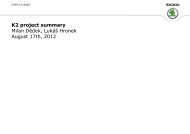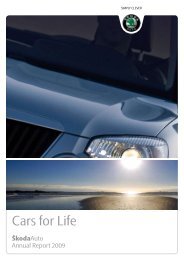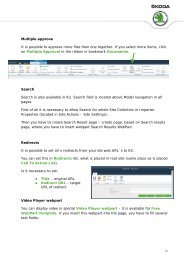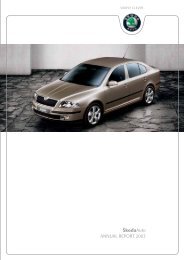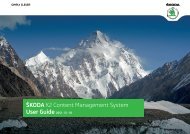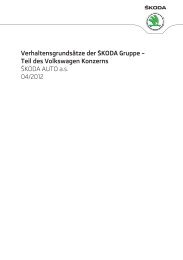Å kodaAuto ANNUAL REPORT 2006 - Skoda Auto
Å kodaAuto ANNUAL REPORT 2006 - Skoda Auto
Å kodaAuto ANNUAL REPORT 2006 - Skoda Auto
Create successful ePaper yourself
Turn your PDF publications into a flip-book with our unique Google optimized e-Paper software.
1.8 Impairment of assets<br />
Assets that are subject to amortisation and depreciation are reviewed for impairment whenever events or changes in circumstances<br />
indicate that the carrying amount may not be recoverable. An impairment loss is recognised for the amount by which the asset’s carrying<br />
amount exceeds its recoverable amount. The recoverable amount is the higher of an asset’s fair value less costs to sell and value in use. For<br />
the purposes of assessing impairment, assets are grouped at the lowest levels for which there are separately identifiable cash flows<br />
(cash-generating units).<br />
1.9 Financial assets<br />
The Group classifies its financial assets in the following categories: financial assets at fair value through profit or loss; loans and receivables;<br />
held-to-maturity investments; and available-for-sale financial assets. The classification depends on the purpose for which the financial<br />
assets were acquired. Management determines the classification of its financial assets at initial recognition and re-evaluates this<br />
designation at every reporting date.<br />
(a) Financial assets at fair value through profit or loss<br />
Financial assets at fair value through profit or loss are financial assets held for trading. A financial asset is classified in this category if<br />
acquired principally for the purpose of selling in the short term or if so designated by management. Derivatives are also categorised as<br />
held for trading unless they are designated as hedging instruments. Assets in this category are classified as current assets.<br />
(b) Loans and receivables<br />
Loans and receivables are non-derivative financial assets with fixed or determinable payments that are not quoted in an active market.<br />
They arise when the Group provides money, goods or services directly to a debtor with no intention of trading the receivable. They are<br />
included in current assets, except for maturities greater than 12 months after the balance sheet date. These are classified as non-current<br />
assets. Loans and receivables are classified as trade receivables, or other receivables and financial assets in the balance sheet (Note 6 and<br />
Note 8).<br />
(c) Held-to-maturity investments<br />
Held-to-maturity investments are non-derivative financial assets with fixed or determinable payments and fixed maturities that the<br />
Group’s management has the positive intention and ability to hold to maturity. During the years presented in these consolidated financial<br />
statements the Group did not hold any investments in this category.<br />
68








